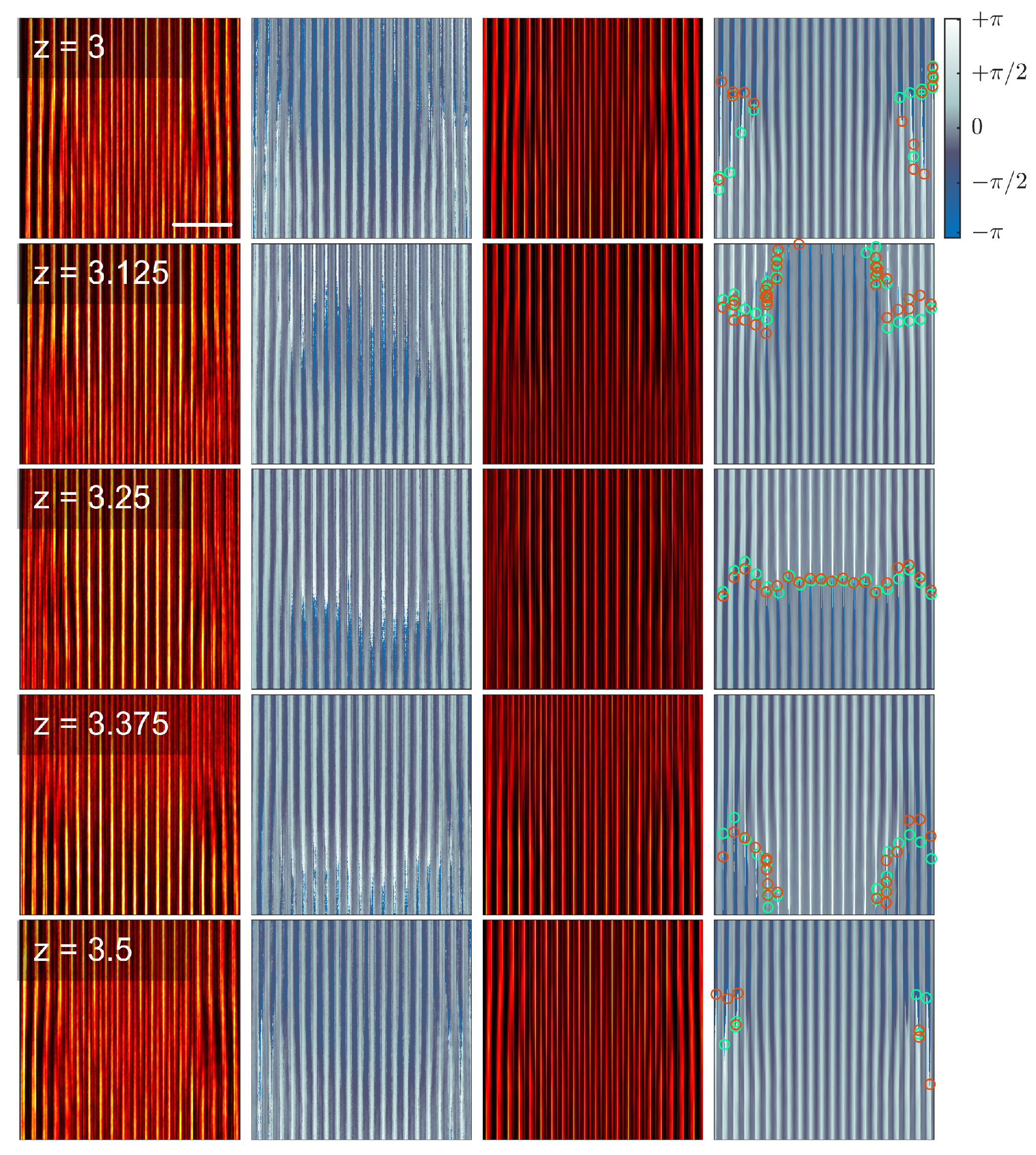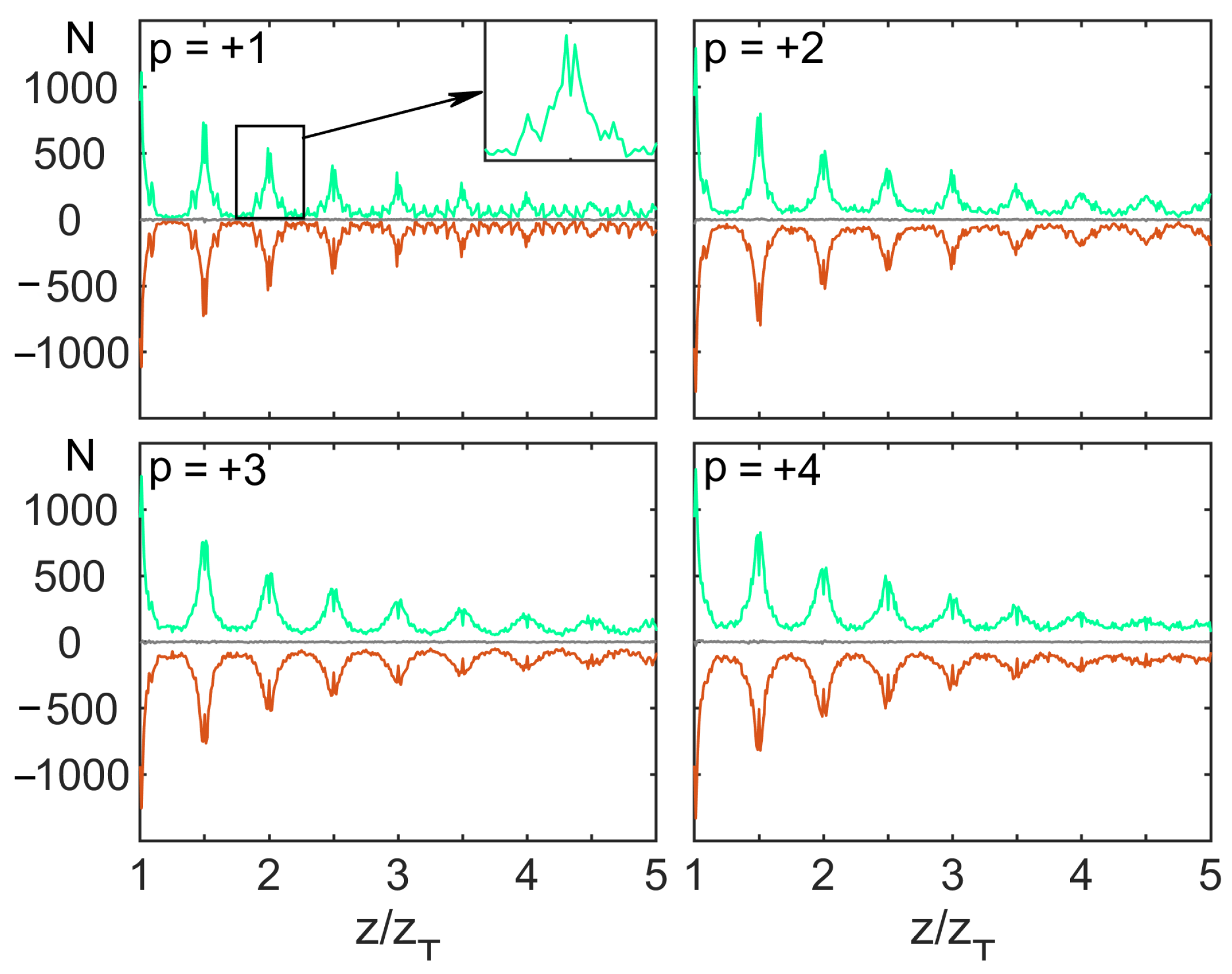Near-Field Evolution of Optical Vortices and Their Spatial Ordering behind a Fork-Shaped Grating
Abstract
1. Introduction
2. Basic Formulas
3. Experimental Setup
4. Results and Discussion
5. Conclusions
Author Contributions
Funding
Institutional Review Board Statement
Informed Consent Statement
Data Availability Statement
Acknowledgments
Conflicts of Interest
References
- Rubinsztein-Dunlop, H.; Forbes, A.; Berry, M.V.; Dennis, M.R.; Andrews, D.L.; Mansuripur, M.; Denz, C.; Alpmann, C.; Banzer, P.; Bauer, T.; et al. Roadmap on structured light. J. Opt. 2016, 19, 013001. [Google Scholar] [CrossRef]
- Forbes, A.; de Oliveira, M.; Dennis, M.R. Structured light. Nat. Photon. 2021, 15, 253–262. [Google Scholar] [CrossRef]
- Ikonnikov, D.A.; Kotlyar, V.V.; Kovalev, A.A.; Vyunishev, A.M. Optical Vortices with A Quadratic Azimuthal Phase Dependence. Ann. Der Phys. 2022, 534, 2200276. [Google Scholar] [CrossRef]
- Allen, L.; Beijersbergen, M.W.; Spreeuw, R.J.C.; Woerdman, J.P. Orbital angular momentum of light and the transformation of Laguerre-Gaussian laser modes. Phys. Rev. A 1992, 45, 8185–8189. [Google Scholar] [CrossRef]
- Soskin, M.S.; Gorshkov, V.N.; Vasnetsov, M.V.; Malos, J.T.; Heckenberg, N.R. Topological charge and angular momentum of light beams carrying optical vortices. Phys. Rev. A 1997, 56, 4064–4075. [Google Scholar] [CrossRef]
- Knyazev, B.A.; Serbo, V.G. Beams of photons with nonzero projections of orbital angular momenta: New results. Phys. Usp. 2018, 61, 449–479. [Google Scholar] [CrossRef]
- Porfirev, A.P.; Kuchmizhak, A.A.; Gurbatov, S.O.; Juodkazis, S.; Khonina, S.N.; Kul’chin, Y.N. Phase singularities and optical vortices in photonics. Phys. Usp. 2021, 192, 841–866. [Google Scholar] [CrossRef]
- Kotlyar, V.V.; Kovalev, A.A.; Volyar, A.V. Topological charge of a linear combination of optical vortices: Topological competition. Opt. Express 2020, 28, 8266–8281. [Google Scholar] [CrossRef]
- Kotlyar, V.; Kovalev, A.; Kozlova, E.; Savelyeva, A.; Stafeev, S. Geometric Progression of Optical Vortices. Photonics 2022, 9, 407. [Google Scholar] [CrossRef]
- Mirhosseini, M.; Magaña-Loaiza, O.S.; O’Sullivan, M.N.; Rodenburg, B.; Malik, M.; Lavery, M.P.J.; Padgett, M.J.; Gauthier, D.J.; Boyd, R.W. High-dimensional quantum cryptography with twisted light. N. J. Phys. 2015, 17, 033033. [Google Scholar] [CrossRef]
- Sit, A.; Bouchard, F.; Fickler, R.; Gagnon-Bischoff, J.; Larocque, H.; Heshami, K.; Elser, D.; Peuntinger, C.; Günthner, K.; Heim, B.; et al. High-dimensional intracity quantum cryptography with structured photons. Optica 2017, 4, 1006–1010. [Google Scholar] [CrossRef]
- Willig, K.I.; Rizzoli, S.O.; Westphal, V.; Jahn, R.; Hell, S.W. STED microscopy reveals that synaptotagmin remains clustered after synaptic vesicle exocytosis. Nature 2006, 440, 935–939. [Google Scholar] [CrossRef]
- Gahagan, K.T.; Swartzlander, G.A. Optical vortex trapping of particles. Opt. Lett. 1996, 21, 827–829. [Google Scholar] [CrossRef]
- Wang, B.; Tanksalvala, M.; Zhang, Z.; Esashi, Y.; Jenkins, N.W.; Murnane, M.M.; Kapteyn, H.C.; Liao, C.T. Coherent Fourier scatterometry using orbital angular momentum beams for defect detection. Opt. Express 2021, 29, 3342–3358. [Google Scholar] [CrossRef]
- Li, Z.; Liu, T.; Ren, Y.; Qiu, S.; Wang, C.; Wang, H. Direction-sensitive detection of a spinning object using dual-frequency vortex light. Opt. Express 2021, 29, 7453–7463. [Google Scholar] [CrossRef]
- Bazhenov, V.Y.; Vasnetsov, M.V.; Soskin, M.S. Laser beams with screw dislocations in their wavefronts. JETP Lett. 1991, 52, 429–431. [Google Scholar]
- Heckenberg, N.; McDuff, R.; Smith, C.; Rubinsztein-Dunlop, H.; Wegener, M. Laser-beams with phase singularities. Opt. Qunt. Electron. 1992, 24, S951–S962. [Google Scholar] [CrossRef]
- Ikonnikov, D.A.; Fokin, V.A.; Vyunishev, A.M. Synthesizing Structured Optical Vortices. Ann. Der Phys. 2022, 534, 2200041. [Google Scholar] [CrossRef]
- Ikonnikov, D.A.; Myslivets, S.A.; Davletshin, N.N.; Baron, F.A.; Arkhipkin, V.G.; Vyunishev, A.M. Unveiling Talbot Effect under Fresnel Diffraction at a Fork-Shaped Grating. Ann. Der Phys. 2023, 535, 2200480. [Google Scholar] [CrossRef]
- Janicijevic, L.; Topuzoski, S. Fresnel and Fraunhofer diffraction of a Gaussian laser beam by fork-shaped gratings. J. Opt. Soc. Am. A 2008, 25, 2659. [Google Scholar] [CrossRef]
- Topuzoski, S.; Janicijevic, L. Fraunhofer diffraction of a Laguerre–Gaussian laser beam by fork-shaped grating. J. Mod. Opt. 2011, 58, 138–145. [Google Scholar] [CrossRef]
- Wen, J.; Zhang, Y.; Xiao, M. The Talbot effect: Recent advances in classical optics, nonlinear optics, and quantum optics. Adv. Opt. Photon. 2013, 5, 83–130. [Google Scholar] [CrossRef]
- Knyazev, B.; Kameshkov, O.; Vinokurov, N.; Cherkassky, V.; Choporova, Y.; Pavelyev, V. Quasi-Talbot effect with vortex beams and formation of vortex beamlet arrays. Opt. Express 2018, 26, 14174–14185. [Google Scholar] [CrossRef]
- Rasouli, S.; Hebri, D. Theory of diffraction of vortex beams from 2D orthogonal periodic structures and Talbot self-healing under vortex beam illumination. J. Opt. Soc. Am. A 2019, 36, 800–808. [Google Scholar] [CrossRef]
- Kotelnikov, I.A.; Kameshkov, O.E.; Knyazev, B.A. Diffraction of bessel beams on 2D amplitude gratings—a new branch in the talbot effect study. J. Opt. 2020, 22, 065603. [Google Scholar] [CrossRef]
- Ikonnikov, D.A.; Myslivets, S.A.; Volochaev, M.N.; Arkhipkin, V.G.; Vyunishev, A.M. Two-dimensional Talbot effect of the optical vortices and their spatial evolution. Sci. Rep. 2020, 10, 20315. [Google Scholar] [CrossRef]
- Arkhipkin, V.G.; Myslivets, S.A. Diffraction of vortex Gaussian beams from a two-dimensional Raman-induced grating. Las. Phys. 2021, 31, 065401. [Google Scholar] [CrossRef]
- Choporova, Y.; Knyazev, B.; Pavelyev, V. Holography with high-power CW coherent terahertz source: Optical components, imaging, and applications. Light. Adv. Manuf. 2022, 3, 1. [Google Scholar] [CrossRef]
- Matta, S.; Vayalamkuzhi, P.; Naik, D.N.; Viswanathan, N.K. Evolution of phase singularities from fork-shaped phase grating in the near-field. J. Opt. 2018, 20, 075604. [Google Scholar] [CrossRef]
- Goodman, J. Introduction to Fourier Optics; McGraw-Hill physical and quantum electronics series; W. H. Freeman: New York, NY, USA, 2005. [Google Scholar]
- Voelz, D.G. Computational Fourier Optics: A MATLAB Tutorial; SPIE: St Bellingham, WA, USA, 2011. [Google Scholar] [CrossRef]
- Gerchberg, R.W.; Saxton, W.O. A practical algorithm for the determination of phasefrom image and diffraction plane pictures. Optik 1972, 35, 237–246. [Google Scholar]




Disclaimer/Publisher’s Note: The statements, opinions and data contained in all publications are solely those of the individual author(s) and contributor(s) and not of MDPI and/or the editor(s). MDPI and/or the editor(s) disclaim responsibility for any injury to people or property resulting from any ideas, methods, instructions or products referred to in the content. |
© 2023 by the authors. Licensee MDPI, Basel, Switzerland. This article is an open access article distributed under the terms and conditions of the Creative Commons Attribution (CC BY) license (https://creativecommons.org/licenses/by/4.0/).
Share and Cite
Ikonnikov, D.A.; Myslivets, S.A.; Arkhipkin, V.G.; Vyunishev, A.M. Near-Field Evolution of Optical Vortices and Their Spatial Ordering behind a Fork-Shaped Grating. Photonics 2023, 10, 469. https://doi.org/10.3390/photonics10040469
Ikonnikov DA, Myslivets SA, Arkhipkin VG, Vyunishev AM. Near-Field Evolution of Optical Vortices and Their Spatial Ordering behind a Fork-Shaped Grating. Photonics. 2023; 10(4):469. https://doi.org/10.3390/photonics10040469
Chicago/Turabian StyleIkonnikov, Denis A., Sergey A. Myslivets, Vasily G. Arkhipkin, and Andrey M. Vyunishev. 2023. "Near-Field Evolution of Optical Vortices and Their Spatial Ordering behind a Fork-Shaped Grating" Photonics 10, no. 4: 469. https://doi.org/10.3390/photonics10040469
APA StyleIkonnikov, D. A., Myslivets, S. A., Arkhipkin, V. G., & Vyunishev, A. M. (2023). Near-Field Evolution of Optical Vortices and Their Spatial Ordering behind a Fork-Shaped Grating. Photonics, 10(4), 469. https://doi.org/10.3390/photonics10040469




